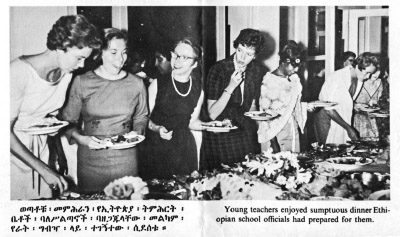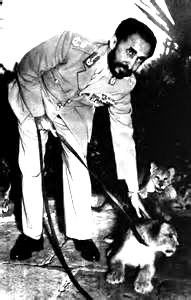The Lion in the Gardens of the Guenet Hotel (Ethiopia)
by John Coyne (Ethiopia 1962–64)
•

The caption reads: “Young teachers enjoyed sumptuous dinner Ethiopian school official had prepared for them. ” Identified from left Carolyn Wood, Mary Stefano, Margaret Wagner . . .
In the final days of our in-country Peace Corps training in Ethiopia, we had a celebration dinner at the Guenet Hotel in the Populari section of the capital, Addis Ababa.
The Guenet Hotel, even in 1962, was one of the older hotels in Addis Ababa. It wasn’t in the center of town, but south of Smuts Street and down the hill from Mexico Square, several miles from where we were housed in the dormitories of Haile Selassie I University. While out of the way, this small, two-story rambling hotel, nevertheless, had a two-lane, American-style bowling alley, tennis courts, and a most surprising of all, an African lion in its lush, tropical gardens.

Emperor Haile Selassie with some of his lion cubs
At that time in the Empire, no Ethiopian was allowed to keep a lion, the symbol of the Emperor, Haile Selassie, whose full title was “By the Conquering Lion of the Tribe of Judah, His Imperial Majesty Haile Selassie I, King of Kings, Lord of Lords, Elect of God,” had a private collection of animals, including the Imperial lions, antelopes, and monkeys, as well as cheetahs, all at Jubilee Palace, his royal residence.
There was also a small government lion park near the main campus of Haile Selassie I University at Sidist Kilo, a quarter mile below the American Embassy. This park had about twenty full-grown lions in a large circular cage and sometimes late at night we would hear them from the University roaring in the distance.
Occasionally a wild lion would wander down from nearby Mt. Entoto looking for food and could be spotted by townspeople. That would create headlines and eye-witness accounts in the next day’s morning paper.
So, seeing a lion up close and personal in the heart of Africa was possible, and something special for a group of young American new to Africa.
Over 275 Peace Corps Volunteer teachers had arrived in Addis Ababa in September of 1962 at the end of the African Highland long rains. We were the first Peace Corps Volunteers to Ethiopia and in our final days in Addis Ababa, before being dispatched to our teaching assignments throughout the Empire, we had a farewell dinner at the Guenet Hotel. It was the first time any of us had been to the Populari section of the city or seen the lovely gardens of this hotel or their caged lion.
Well, actually it was a caged lion and a large German shepherd dog.
As I recall, when I first saw the lion the German shepherd was stretched out comfortably between its paws and both were calmly gazing out through the bars of the small cage at the lot of us. The dog was able to come and go through the bars, but we were told by the hotel staff that he always spend the night sleeping inside the cage, curled up with the lion.
I had been assigned to teach at the Commercial Secondary School in Addis Ababa, and in the early fall of that year was living in the Populari section of the city, near the Guenet Hotel.
The Peace Corps had issued bicycles to whomever needed them to get to school, and I settled into the routine of riding back and forth to classes, and stopping off at the hotel for a coke or coffee after school to correct my students English homework while sitting in the gardens of the Guenet surrounded by thick bougainvillaea bushes, wild roses and carnations, and gnarled cedars draped with streamer-like leaves. It was here that I came to know the lion and the German shepherd, who often slipped out through the bars to beg food from me while the male lion stood at attention against the bars of the cage silently watching the transaction. They were quite an odd couple.
On one of my mid-day rides home for lunch, when I was pell-melling down one of the a steep hills of the city, an American pulled his car up alongside and singled me to stop.
He turned out to be a TWA pilot employed by Ethiopian Airlines and he invited me, and several others Volunteers, to a “home cooked” dinner that weekend. It was his way of welcoming the new Peace Corps Volunteers to the Empire.
Trans World Air Lines had managed Ethiopian Airlines since 1946 and by the time we reached the Empire in ’62 over a third of the trained pilots were Ethiopians. The management by TWA of the Ethiopian Airlines is one of the great early success stories of private development in Africa.
The American pilot who invited me to dinner had been in-country for several years and when I mentioned the Guenet and the lion in the garden he asked me if I knew the story of how the lion had gotten to the hotel.
It seems the first American TWA director in Ethiopia had raised the lion from a small cub in the garden of his home’s compound along with the family’s dog. The lion was such a household pet that everyone who visited the house treated it as such.
Then there came a time the CEO of TWA worldwide came to Ethiopia to meet the Emperor, and visit his overseas operation. He arrived at dawn in Addis Ababa on an overnight flight from Europe and immediately took a morning nap at the director’s home.
Late that afternoon, rested, the CEO was sitting with a half dozen American pilots who had stopped by for a drink and to visit with their boss from America. They were all sitting in the living room of the house with French doors open to the garden, watching the African sunset and enjoying the first cool breezes of evening.
Sometime towards dusk, the lion, who had been asleep in the sunny terrace beyond the French doors, woke up and ambled passed the open door, gazed in at the assembled group, and then ambled off.
No one commented about the lion, as all the pilots knew about the animal. However, the visiting CEO had no idea the full-main lion was a household pet and sat petrified at the sight of the African beast, loose and only yards away from him.
Terrified, he didn’t say anything until the next morning when he confessed to his host what he thought he had seen, thinking it must have been a frightening fantasy caused by his fear of being in Africa.
In time, the American manager’s tour in Ethiopia was finished and he and his family decided to give the lion to the nearby hotel as the tame animal could not be returned to the wild. The German shepherd, however, would go home to America with the family.
In the weeks before their departure from Addis, the lion was successfully transferred to the gardens of the Guenet Hotel, but when the family realized the German shepherd was so lonely and unhappy with the loss of his companion they decided to leave the dog, giving it to the Guenet where both animals could live peacefully in the small cage in the hotel gardens. And it was there that we found them when we arrived in Addis Ababa.
I left Ethiopia in the mid-sixties and did not return again until the early ’70s. While I had a short list of old friends in Addis that I wanted to see, high on my list were the lion and the German shepherd in the gardens of the Guenet.
A day or so after arriving in Addis, I took a taxi to the hotel which had thankfully not changed much in the years I had been away and walked into the garden to find the cage.
The cage was where I remembered it. However, the door was wide open and the lion was gone. Sitting alone in the middle of the empty concrete floor was the old German shepherd.
I walked inside to the front desk of the hotel and asked about the lion and was told the animal had passed away only months before. In fact, it was such a news event a story had been written about his death in the Ethiopian Herald, the English newspaper in the country. The staff found a copy of the article that detailed the demise of the lion and I sat down in the lobby of the old hotel and read the account.
Several months early when the lion was suffering from an infected tooth doctors from the Pasteur Institute of Ethiopia decided to drug the animal so the tooth could be extracted. Unfortunately, the dart of drugs was too much for the old animal and it died before it could be saved.
The hotel had not yet decided what to do about the lion cage for the dog still lived there, spending his days waiting for his lifelong companion to return.
I gave the article back to the receptionist, thanked him for the information, and went out into the garden and walked through the open gate and inside the cage. I knelt down beside the German shepherd and petted the old dog one last final time, then I left Addis Ababa and Africa.
I have never been back.
Another great story, John. Keep them coming!
Life is such a phenomenon which he can not live it again. If he lived it it will be only in his memories. In my opinion a life, whether or not Good, that is not livable again is not a life.
Thanks for sharing your memories. They make home sick but I enjoyed them.
I agree! Book! Book! Book!
This is a wonderful story which could become a classic for children. Thank you, John.
A book of your essays on the Peace Corps experience would be a great service for new volunteers in training. The personal insights to a new place and what the volunteers can learn from the foreign culture would be a wonderful adjunct to the training material.
Say John;
great story about the lion and the german shepard. When i went back to Ethiopia in 1967, I think, I took over your spot as Associate director in Ethiopia. I remember the Guenet Hotel and some of the attributes there, but I don’t recall the Dog. The lion had died by the time i returned.
As usual yo u have writtne a good story. I enjoy reading you work. I loved the story of Bati and the husband and wife relationship when you were there. You write very well.
Nice contacting you again.
love
jon and freddie
I love this story , in 1959 we moved to Addis Ababa ( I was 9) and we lived at the hotel for 3 months before finding a home , my father ,US Air Force worked at the Air Base , our home was near the TWA. Pilot home and remember visiting when the lion was at his home ! We left in 1964 ..